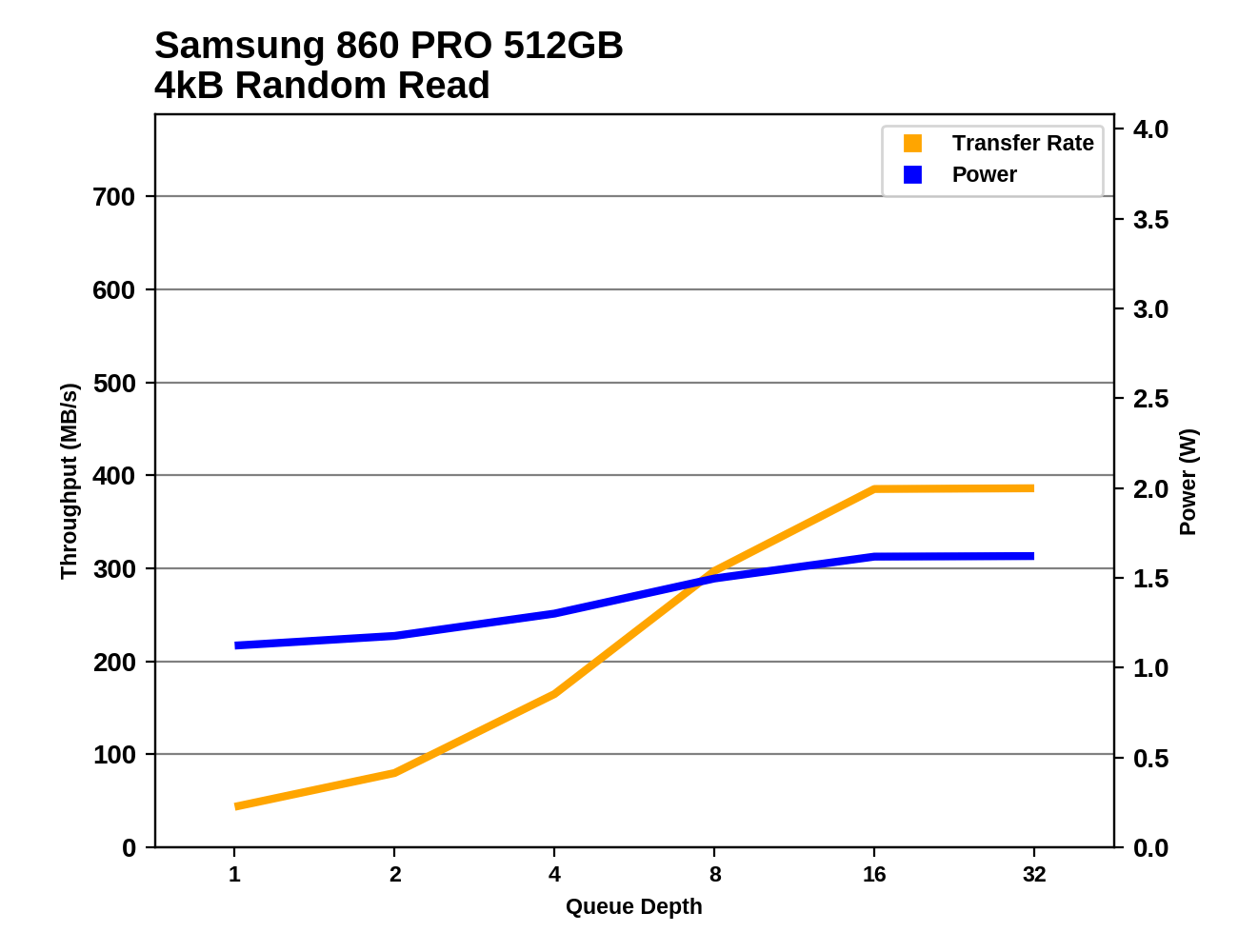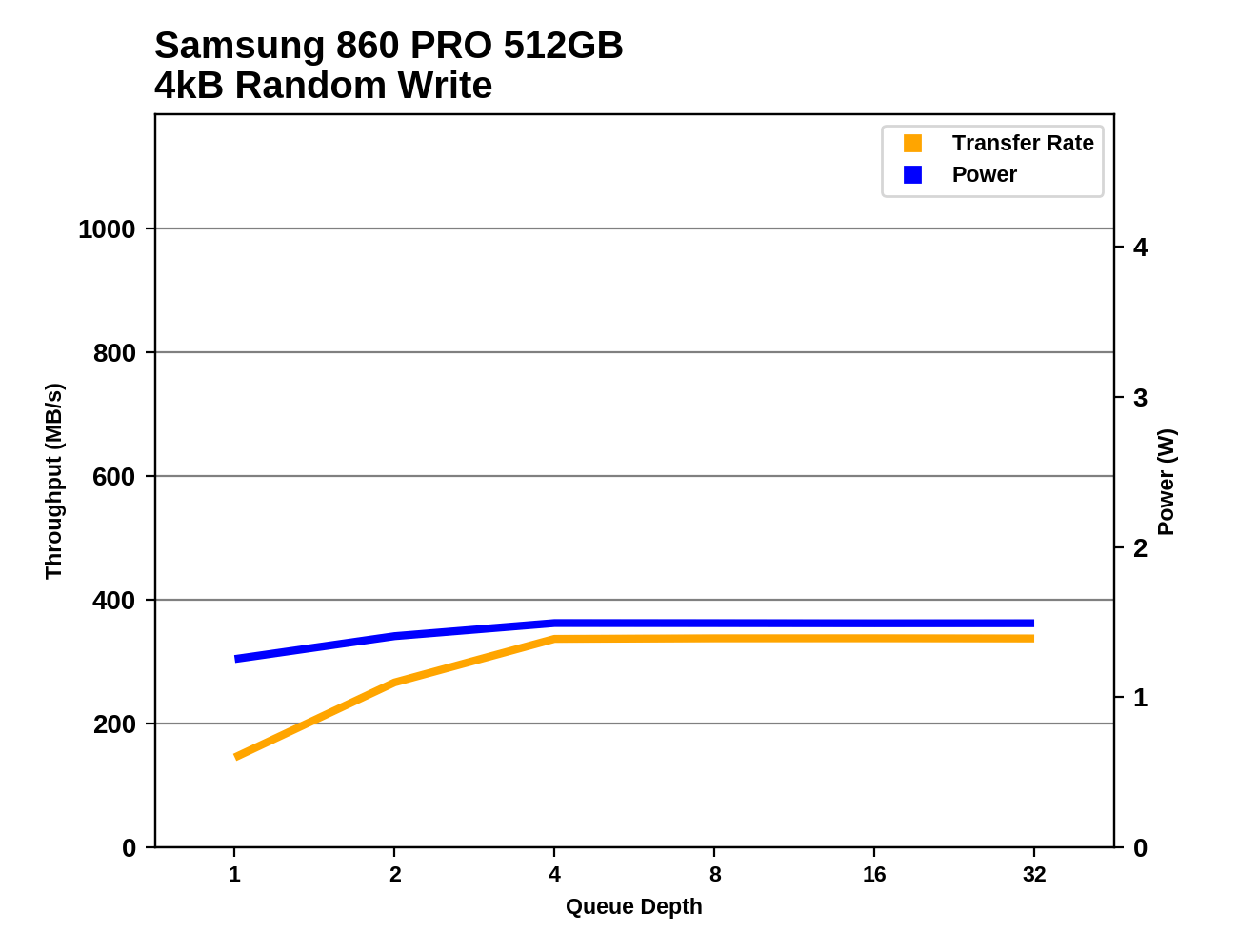The Samsung 860 PRO (512GB And 4TB) SSD Review: Replacing A Legend
by Billy Tallis on January 23, 2018 10:00 AM ESTRandom Read Performance
Our first test of random read performance uses very short bursts of operations issued one at a time with no queuing. The drives are given enough idle time between bursts to yield an overall duty cycle of 20%, so thermal throttling is impossible. Each burst consists of a total of 32MB of 4kB random reads, from a 16GB span of the disk. The total data read is 1GB.

The 512GB Samsung 860 PRO has the fastest burst random read speed among these SATA SSDs, about 5% faster than the 850 PRO. The 4TB model is the same speed as the 4TB 850 EVO.
Our sustained random read performance is similar to the random read test from our 2015 test suite: queue depths from 1 to 32 are tested, and the average performance and power efficiency across QD1, QD2 and QD4 are reported as the primary scores. Each queue depth is tested for one minute or 32GB of data transferred, whichever is shorter. After each queue depth is tested, the drive is given up to one minute to cool off so that the higher queue depths are unlikely to be affected by accumulated heat build-up. The individual read operations are again 4kB, and cover a 64GB span of the drive.

On the longer random read test involving some higher queue depths, the Samsung 860 PROs take a clear lead, and the 4TB model even outperforms the PM981 NVMe SSD.

The two Samsung 860 PROs offer the same power efficiency, which is a huge step up from the 850 PRO's efficiency and significantly better than any of the competition.
 |
|||||||||
Most of the Samsung drives hit the same limit of almost 400 MB/s around QD16. The two latest Crucial SSDs only just reach reach that level of performance at QD32, while the Intel 545s and Crucial MX300 never scale up that far. The PM981 NVMe drive scales far beyond any of the SATA drives, but at the cost of very poor power efficiency, especially at lower queue depths.
Random Write Performance
Our test of random write burst performance is structured similarly to the random read burst test, but each burst is only 4MB and the total test length is 128MB. The 4kB random write operations are distributed over a 16GB span of the drive, and the operations are issued one at a time with no queuing.

The 4TB 860 PRO has the fastest burst random write speed, while the 512GB model scores slightly worse than the 512GB 850 PRO.
As with the sustained random read test, our sustained 4kB random write test runs for up to one minute or 32GB per queue depth, covering a 64GB span of the drive and giving the drive up to 1 minute of idle time between queue depths to allow for write caches to be flushed and for the drive to cool down.

The sustained random write performance of the Samsung 860 PRO is a very slight improvement over their previous drives. Most of the competition is significantly slower on this test, but the Crucial BX300 is pretty close.

The Samsung 860 PROs are again the two most efficient SATA SSDs, and the 512GB model manages to match the efficiency of the much faster but more power hungry PM981.
 |
|||||||||
The 860 PRO reaches full random write speed at QD4 and is steady through the rest of the test. The Crucial MX500 and Intel 545s are much slower to get up to speed, and the SanDisk Ultra 3D plateaus at a mere 200MB/s after QD2.










64 Comments
View All Comments
rocky12345 - Tuesday, January 23, 2018 - link
Great review as always Thank You. I am happy to see my 850 Pro 512GB drive still hanging in there and able to perform with the big guys still in the Sata based drives that is. I am thinking that when I do my whole platform upgrade in the fall of 2018 I will be picking up a Samsung 960 Pro 512GB drive for my new build and most likely keep my current drive in my current system and pass it all on to my wife I am sure she will like the great speed increase going from a 750GB HDD to the Samsung SSD & well all the other goodies in the system as well.WithoutWeakness - Tuesday, January 23, 2018 - link
If you're building an entire new system in the fall I would seriously recommend moving to a PCIe M.2 drive. The 1TB 960 EVO will blow the 1TB 860 PRO out of the water for the same price. The only trade-off is the shorter warranty (3 years vs 5 years).BurntMyBacon - Wednesday, January 24, 2018 - link
I would agree with you, except Rocky said he'll be picking up a 960Pro not an 860Pro.lilmoe - Tuesday, January 23, 2018 - link
I weep every time I see those prices... F'ing ridiculous.imaheadcase - Tuesday, January 23, 2018 - link
Only after you go over 512gig. These prices are pretty tame compared to when the old version came out without the higher end models. You would be paying $500 for that entry one for 256gig.Considering that most people really don't need more than 512gig or even 256g for the average users its pretty nice price. Media is what takes most space on drives, and most stream it or have on separate drive that is bigger.
lilmoe - Tuesday, January 23, 2018 - link
It gets on my nerves to see price actually *increase* per GB for the higher capacities instead of the opposite, which seems to be common place among drives from all vendors.I don't know. I still find it hard to justify a "premium" SSD above 512GB, when you'd want the peace of mind, oh well. Feel my pain?
BurntMyBacon - Wednesday, January 24, 2018 - link
It is especially frustrating to pay more per GB when you see models with the same controller, memory, PCB, and type of NAND chips, but one model has a few more of the NAND chips to get the capacity. Their cost to build (per GB) would come down seeing as they don't need to spend any more on any components except the extra NAND chip. In situations where a different (and low quantity) controller and/or different NAND chips are used, there is some justification, but the premium presented to customers is sometimes disparate to the costs incurred by the manufacturer.Lolimaster - Tuesday, January 23, 2018 - link
Since when a simple MLC 4TB is not a mainstream product? That should be the aim for sata SSD's.Now they try to seel you MLC like it was SLC. For less than $1k we get the 2xCrucial MX500 2TB, yeah TLC, but why MLC needs to be that costly...
BurntMyBacon - Wednesday, January 24, 2018 - link
Now that all the other manufacturers have stepped away from MLC, there is both no direct competition and an artificial shortage (or the appearance there of) for people who want MLC. I imagine the MRSP will not stick around for very long if they want to sell these. Unfortunately, I also imagine that they will settle in to the (still high) price bracket that their 850 series counterparts are at now.comma - Tuesday, January 23, 2018 - link
Could you clarify what capacities are correlated with what size PCB?Are the 256gb and 512gb pcbs the smaller pcb? The anandtech 850 evo review has a section on "inside the drives" where it compares the pcb sizes to the capacity. If you could add something like that for this review, that would be awesome. Many thanks!